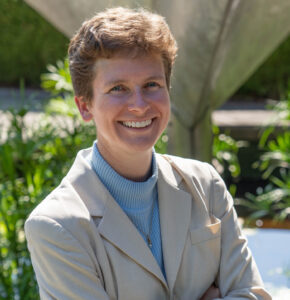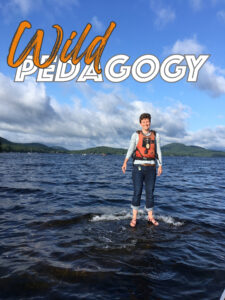
Emboldened by the Wild
 “Can we please go outside?!” my students begged.
“Can we please go outside?!” my students begged.
“Allow me to be your fully-formed pre-frontal cortex,” I told them. “In five minutes, you will be cold just sitting still, and none of you actually wants to sit in the snow.”
An unusually long and unseasonably warm fall last year meant that my classes took place outdoors until the end of October. Then, in an unseasonably early snow dump, we were back inside. The students in my history of Christianity class were not pleased.
They persisted: “We could do a walking class!” As our day on the crusades approached, I thought, I could make this happen. I told them to come prepared for an outdoor walking class. That morning, while I ran, I planned my adapted lesson. It was one of the best classes I have ever taught.
If you had told me when I began teaching ten years ago that I would plan an entire lesson on a 35-minute run the morning of the class, I would have questioned your sanity. I needed detailed plans that I had read over several times so that things would move smoothly. I needed back-up plans for when something didn’t quite work right or an activity didn’t take long enough. I needed to know everything there was to know in case a student asked the question I hadn’t prepared for. Something had changed.
Yes, some of the change is from teaching in general. Doing a thing long enough gives confidence, and teaching long enough teaches flexibility, or at least being okay with flexibility, because no plan survives contact with living, breathing students. But I have noticed that teaching outdoors has emboldened me as a teacher. So much so that I would try something as absurd as an Oregon-Trail-style role-play of the crusades in the snow—students kept dying of dysentery and cholera on our trek around campus.
One reason teaching outside emboldens me is simply that I feel more myself outside. The more I feel like myself—or the more comfortable I feel—when I’m in front of a class, the more likely I am to feel the freedom to risk failure by trying something new or trying something I haven’t fully thought through. What space do you feel most comfortable, most yourself, in? Could you hold a class there? Could you make your classroom feel more like that comfortable place? Is it possible that our students might find it more comfortable too, that they might risk more?
Another thing I’ve discovered is that when I’m teaching outside I feel like I’m getting away with something. So do the students. Class is supposed to be in a cinder-block room at desks with harsh lighting and cause extreme boredom. We almost whisper to each other as we head outside, “Don’t enjoy this too much or the administrators will find out and make us stop!” If I feel like I’m getting away with something, I’m a little exhilarated by the risk and willing to try more. There’s also a conspiratorial spirit I develop with the students: we’re all in this rule-breaking together, so let’s go for broke. They’re more willing to try things. Even better, if they feel they’re getting away with something, they drop their guard and are more willing to play, to try new things, to risk failure. They’re more willing to learn because it doesn’t feel like what they’ve been taught learning feels like.
Finally, things are less likely to go to plan outside, so I have gained a lot of experience about decision-making and confidence. Did it start raining? Is it heavy enough to go inside, or do we wait it out? From those experiences and choices, I have learned that once I make the decision, I need stick with it, no going back and forth. Lawn mowers come too near? I have learned what points are most important in each lesson. Knowing that, I can have fun with the details. Did a student have a medical emergency on a backpacking trip? I learned I can handle real emergencies and think through the steps that need to be taken. These lessons transfer to the classroom as well, where I’ve become a better teacher for knowing my main points and sticking with a decision to keep momentum in a new activity (unless it’s really going poorly and needs intervention) and being able to react calmly to minor incidents.
Having experienced a range of interruptions and impetuses for improvisation, I am emboldened to think that I can handle anything. Sure, I will still be surprised. I will still need help. I can’t handle everything. But the confidence—and also humility—that has risen from teaching outdoors has resulted in more creative lessons, more engaged students, and more effective learning. Emboldened to risk, my students are emboldened to risk, and that’s when all of us can learn. Even while we’re pretending to die of dysentery.
Appendix
Crusades role-play walking class lesson plan
Students have read Justo Gonzalez, Story of Christianity vol. 1, pp. 345-351, and Bernard of Clairvaux, “In Praise of the New Knighthood”
Numbers are for a class of 15, but could be adjusted for a bigger class (i.e., could have 2 people play the pope collectively, have a couple of assistants to Bernard, etc.)
Explain to the students that we will be role-playing today and walking around campus
Assign major parts:
- 2-3 pilgrims returning from the Holy Land with reports of persecution
- Pope Urban: Will convene the Council of Clermont and lead
- 3-4 Advisors to the Pope: Advise at the Council of Clermont
- Bernard of Clairvaux: Will lead “knight training camp”
- Everyone else is variously council members, crusaders, knights
*Since I was doing this for the first time, I asked two students who I knew were good at understanding the material they had read and who would be game for this kind of role play to be Pope Urban and Bernard, and asked for volunteers to be pilgrims and advisors. It could be done as all volunteer, but it’s good to have in mind who might be especially good and make a direct request as a way of avoiding silence when asking for volunteers. If I hadn’t had those two particular students, I would have needed to get my volunteers the day before so they had time to prepare.
I led them walking around campus and stopped periodically to have an activity and lesson.
First stop: Near the Holy Land
- 2-3 pilgrims run up to our group and tell us what it was like for them on their pilgrimage in the Holy Land—how they were treated, what difficulties Muslim rulers are causing, etc.
- When the pilgrims run out of their own ideas, ask the rest of the class to fill in
- While walking, ask students to think about how they would feel hearing these reports. Who wanted to do something about it and who didn’t? Assign them different kinds of life (farmer, knight, artisan, monk, etc.) and see what they might think.
Second stop: Council of Clermont
- The Pope needs to convene the council and then receive reports from advisors about what needs to happen
- This stop is about getting at the reasons people wanted a crusade and the reason the pope ordered the first one (and then later ones)
- When advisors and pope run out of reasons, the rest of the class fills in further details again
- Pope makes a decision and begins the first crusade
- While walking, discussion of how many crusades there were and how they were different, what reasons were similar and different for each one
- *If group is too big to hear each other while walking, then make another stop quickly after this one to have this discussion.
- Also while walking, periodically point at a student and say “you have died of _____” fill in various ways and reasons they died so students get a sense of the futility of this. Dysentery, an infected cut, robbers, a battle, etc.
Third stop: Knight training camp with Bernard of Clairvaux
- Bernard convenes knight training camp and leads the rest of us in how to be good knights, based on the “In Praise of the New Knighthood” reading.
- I also lead some discussion here about the monastic flavor of Bernard’s new knighthood and other things we need to pick up from the text. Help us understand the people who were doing this
- Wander some more, more discussion about the length and number of crusades, children’s crusades, etc. Continue with “You have died of…”
End back at the classroom and ask how many are still alive, so they have a sense of the magnitude of deaths.
Concluding conversation, reflections on the experience, final important points about content.
Leave a Reply